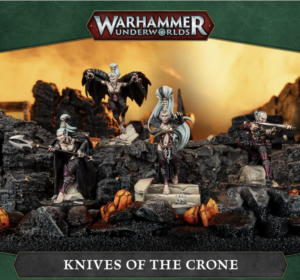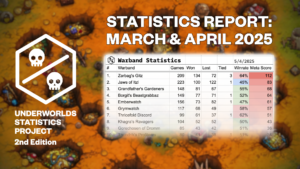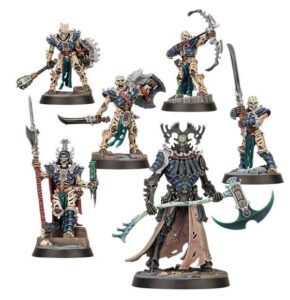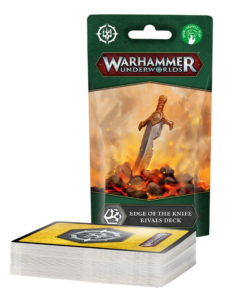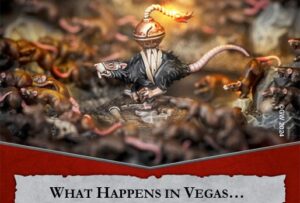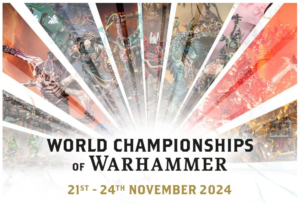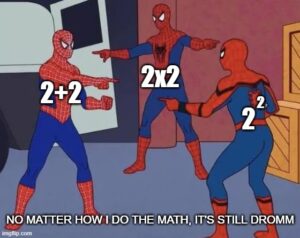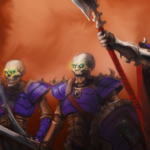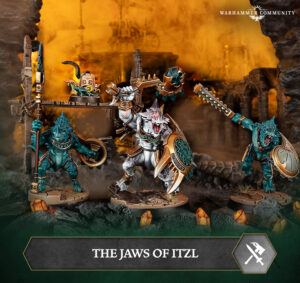Intro
Welcome back to Path to Glory for another Rivals deck review! Thanks again to Games Workshop for providing us with a free copy of the deck to review. Before we start, I want to apologize for the quality of a couple of the images. Unfortunately, the review copy we received appears to have had some printing issues and some ink bled through onto some of the card text. We hope everything is still legible enough, but just wanted to mention it in advance of you folks getting to see the cards for the first time. Anyway, today’s review is of Realmstone Raiders, a deck which runs on making successful attacks and “raiding” cards out of power deck. Interestingly, this will also be our third Rivals deck in the game with a plot card, which of course means that you’re going to see a lot of comments in here about whether it is a compelling choice over Countdown to Cataclysm. I’m definitely a bit skeptical that it can compete in that regard, but there are some angles to the deck which will make it appealing for certain pairings and warbands. And with that extraordinarily vague statement, let’s start getting into the specifics!
Plot Card
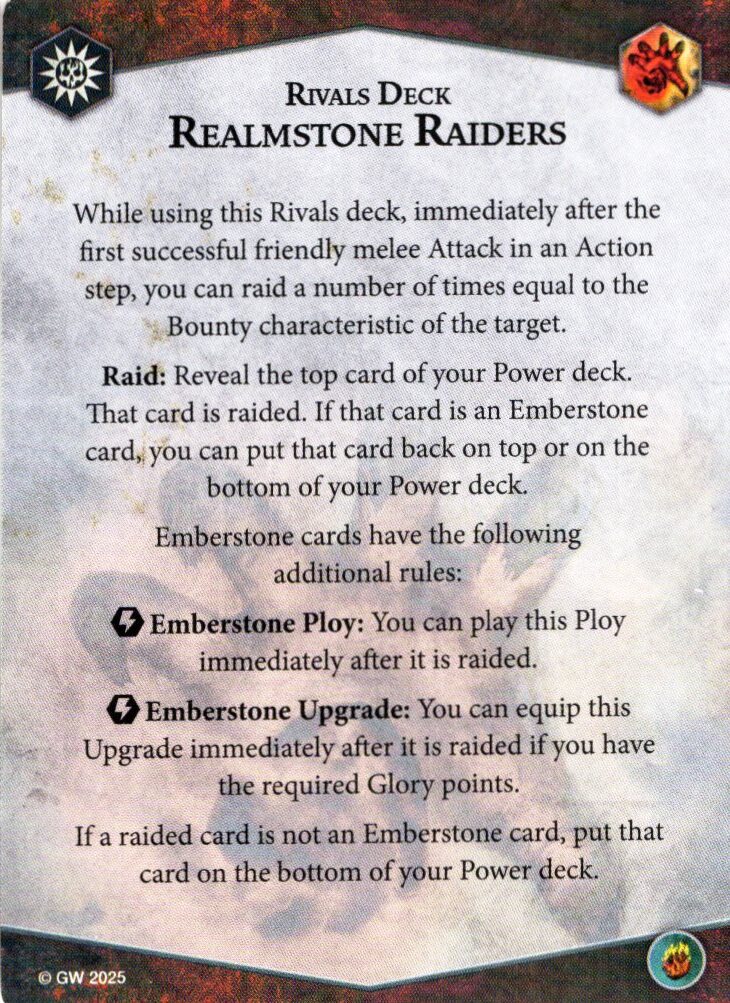
While there is a good bit of text on the plot card, the effect is actually relatively simple. When you make a successful melee attack while playing this deck, you can raid a number of times equal to the bounty characteristic of the target. When you raid, you reveal the top card of your power deck. If it is an Emberstone card, you have the option to leave it on top of your deck, put it to the bottom of your deck, or resolve its surge ability. For Emberstone ploys, this means resolving the effect of the ploy immediately, while for upgrades, you may immediately equip them (if you have the glory points to do so). These effects mean you get to chew through your power cards more rapidly than you would otherwise be able to, but the inherent cost is that it means you would be using them in that moment rather than holding them for a more opportune moment. Still, if you draw one of these Emberstone cards and don’t feel the need to use it immediately, having the option to put it either on top of or on the bottom of your deck is a nice option as “free” information, with the caveat that you are always sharing that information with your opponent. However, despite having the ability to get a bit of a card advantage going, you can also potentially disadvantage yourself in cases where the card you draw does not have the Emberstone keyword, as these will be revealed and then immediately placed on the bottom of your deck. While this might sometimes be nice if you don’t need them until later, it might not feel so good when you end up moving high value cards like Great Strength or such to the bottom of your deck, as you might not get to see them for a while unless you have fantastic card draw economy and/or have many more opportunities to raid and churn them back through to the top of the deck. Overall, the best value here appears to be when you can raid an Emberstone card and immediately play it, as this will essentially be augmenting your draw rate through your power deck.
Objectives
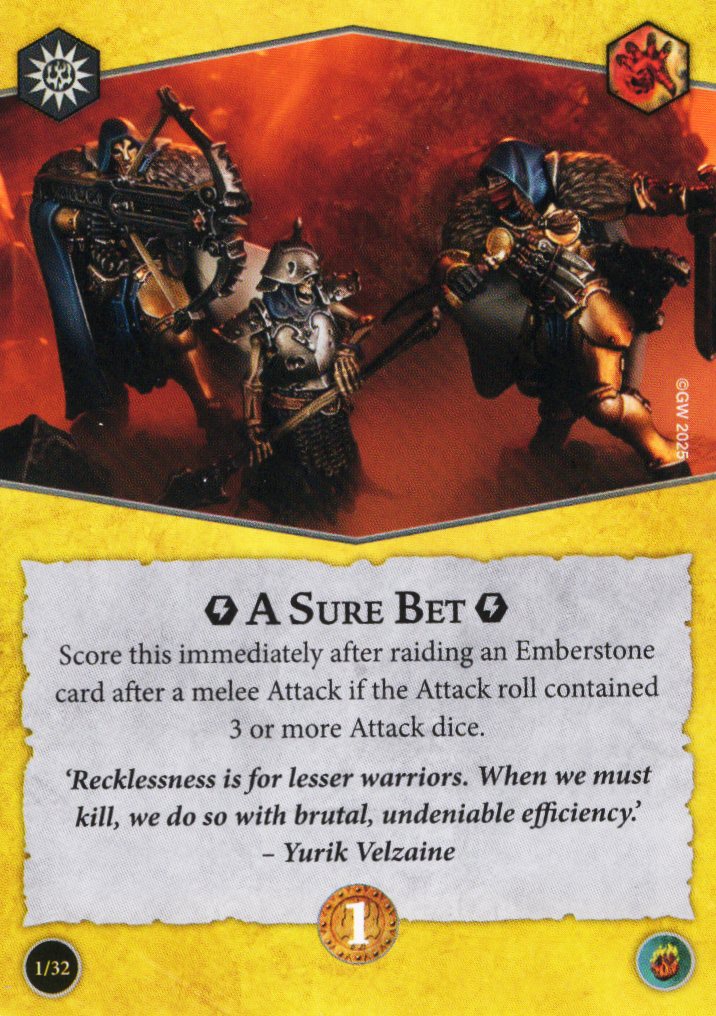
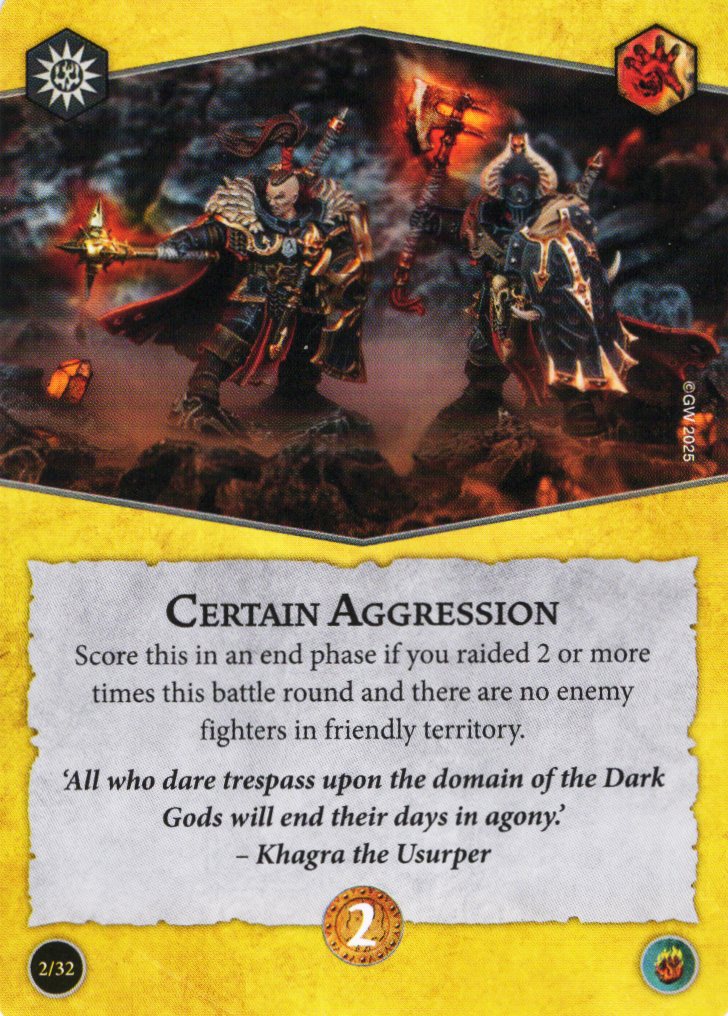
Our first surge objective in the deck, A Sure Bet scores immediately after raiding an Emberstone card from a melee attack if the attack roll contained 3 or more Attack dice. This gives me some vibes of Overwhelming Force from CtC, reducing the dice requirement by 1 while adding the Emberstone card raid condition, which is a fair enough tradeoff. Within the context of the Rivals deck, I think this is fine, as 12/20 power cards do have the Emberstone tag and it is very possible you are raiding more than one at a time. That said, Nemesis is a bit of a different beast, as you certainly should not be taking all 12 in a pairing. Inclusion of this card depends heavily on how many Emberstone cards you expect to play, so strong power deck pairings such as with Blazing Assault may limit the upside here a bit. Still, if your warband has a plethora of 3+ dice melee attacks, you’ll eventually churn into an Emberstone here and there, especially if you had raided one previously and left it on top of your deck in anticipation of drawing this objective later. Not the best surge in the game by any means, but serviceable enough to make the cut if you can manage to fit something like 6+ Emberstone cards into the deck.
Power Ceiling: 2, Consistency: 2, Universality: 2
Certain Aggression is our first end phase card in the deck, scoring for 2 glory if you raided two or more times in the battle round and no enemy fighters are in friendly territory. While I think the plot card stating that you “raid a number of times…” makes it clear enough RaW that this card should score even if you only had one “instance” of raiding that pulled two or more cards (e.g, from hitting a 2-Bounty fighter with a melee attack), I would like to see some FaQ clarification confirming that is the case. Using that as my interpretation of the card, I think this is pretty solid. Denial for 2 glory in any end phase is pretty decent payoff and raiding just twice in a battle round should be pretty doable unless the game is going horribly wrong for you. Cheating ahead a bit, the power deck also gives you a way to raid via ploy, and there is another ploy which enables raiding on a ranged attack instead, either of which can still support this score, unlike our previous entry. While you may struggle to keep folks out in some matchups, particularly once they know you have this card, I like the amount of agency both players have here. You will often need to spend turns and resources driving the enemy from your territory, but more passive strategies may also just do your work for you. I think the payout is well-balanced with the amount of work it is asking you to do and there is reasonable counterplay available for canny opponents. Great card design.
Power Ceiling: 2, Consistency: 2, Universality: 2


A far cry from its Blazing Assault counterpart, Critical Risk is a surge objective which requires you to make a successful attack with a crit in the roll and raid an Emberstone card. This one is just asking a bit too much for me when Critical Effort is right there. You get the same payout with not one, but two additional conditions to satisfy? No thanks. As it is, Critical Effort can sometimes get stuck in hand if your dice just don’t cooperate, even if you are otherwise hitting your attacks. Adding extra layers on top of it is just very undesirable for me, and it will get even worse if you aren’t planning to include many Emberstone cards in the first place.
Power Ceiling: 1, Consistency: 1, Universality: 2
Emberstone Stash scores one glory in an end phase for raiding 4 or more Emberstone cards this round. Even if you take all 12 of them in your deck (which I very much do not recommend), the math says you’d probably need to raid something like 8 cards in the first round to have good odds of scoring this (depending on how many happened to land in your opening power hand), which is an absurdly high number. Even raiding 4 cards will be a tall task against hordes that have all 1-Bounty fighters, as that would likely mean you need to hit all 4 attacks that round (barring some very limited power deck support that could help you slightly). Run into a warband that is raising fighters or just otherwise dangling 0-Bounty fighters and this card goes straight to the trash for me. Things get even worse when you consider that you might happen to draw this in Round 3 when you may not even have 4 Emberstone cards left in your deck to raid. Even if this were worth 2 glory, I wouldn’t think twice about skipping it.
Power Ceiling: 1, Consistency: 1, Universality: 1
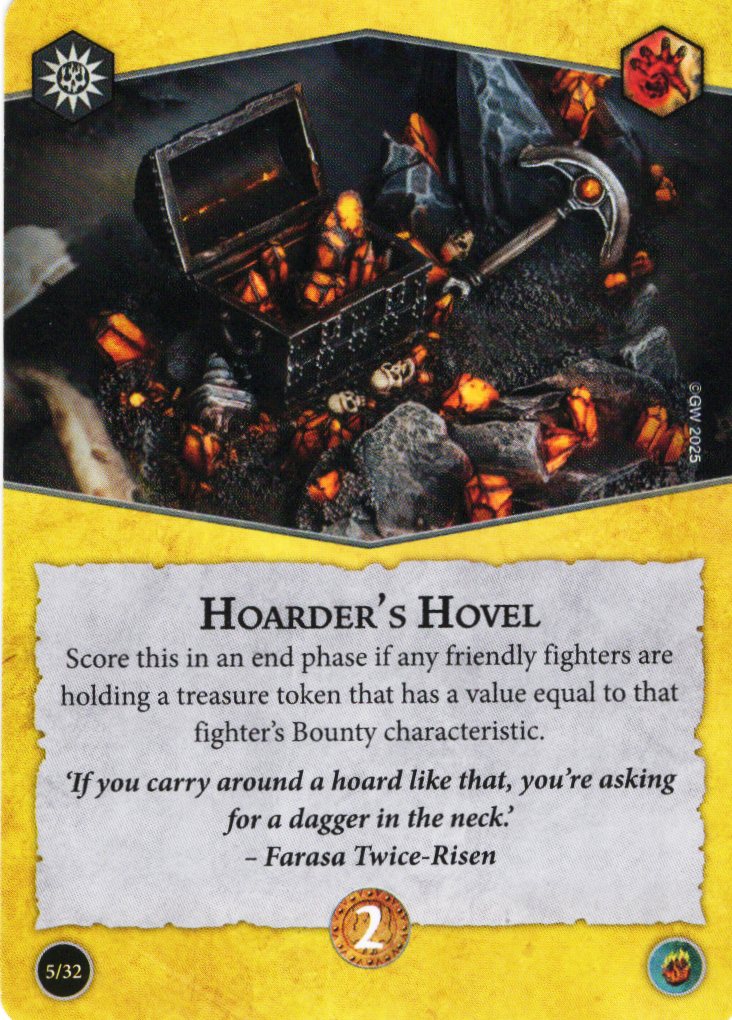
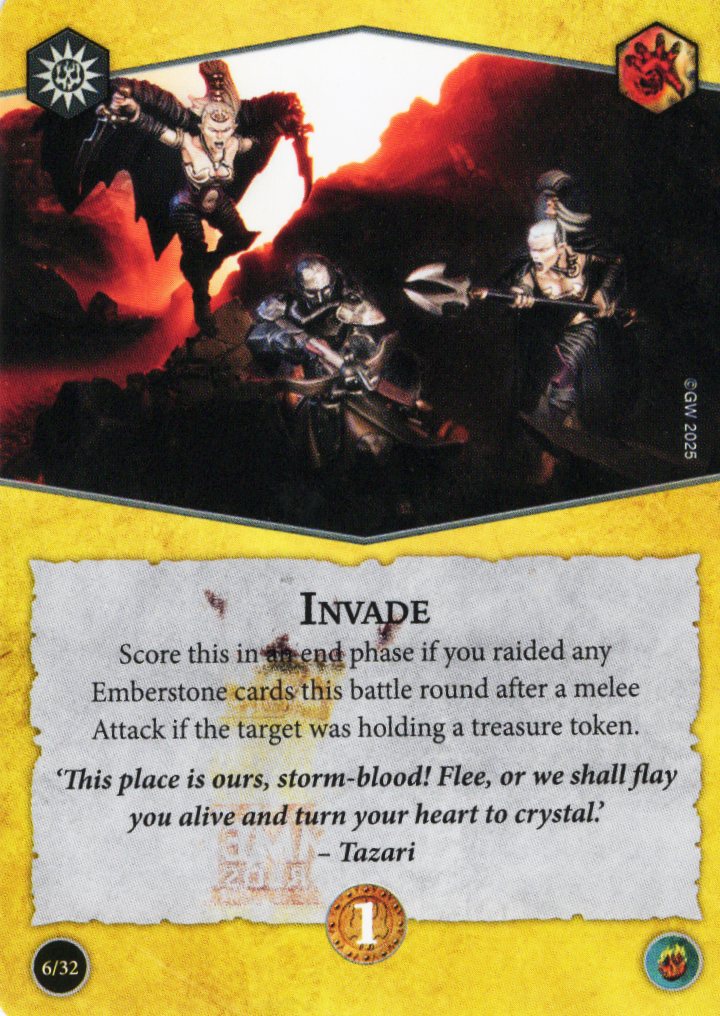
Speaking of 2-glory end phases, Hoarder’s Hovel scores in the end phase if any friendly fighters are holding a treasure token with a value equal to their Bounty characteristic. As there is no way to manipulate your Bounty (other than to make it 0 via raise, which will not help here), you want a distribution in your warband if you are going to play this. After looking through the slate of currently-released warbands, only Dread Pageant, Headsmen’s Curse, and Zikkit’s Tunnelpack have a 3, 2, and 1 Bounty fighter in the warband, making them best-suited for this card from that perspective. However, I would be remiss not to point out deck pairings with Emberstone Sentinels, particularly for 4- and 5-fighter warbands with a mix of 2 and 1 Bounty fighters, as you can play for this in tandem with Hold Treasure Token 1 or 2 and take Switch Things Up to pull the correctly-numbered token into your territory for safe keeping. While not quite as consistent as something like Iron Grasp or Set Explosives, being able to score 2 glory for holding just one token is an attractive prospect, so I think you will be able to manage it relatively well as long as you have at least two different Bounty characteristics to try for it. Not very good for raise warbands though, sadly.
Power Ceiling: 3, Consistency: 2, Universality: 2
You know how folks will often lament needing to track treasure token delving for Broken Prospects while playing PnP? Invade is a 1-glory end phase objective if you raided any Emberstone cards this round after a melee attack if the target was holding a treasure token. One of the few things I dislike more in my objectives than having to count on very restrictive positioning requirements for my opponent’s fighters is having to remember that it may have happened several turns ago and having to remember what card I raided from my deck at the time that thing happened. The good news is that you can avoid this headache altogether by just leaving the card out of your deck because it is not very good. Too dependent on enemy positioning and again too dependent on your draw order, two things you have very little control over for very little payoff. I feel like maybe this one was a surge at one point, but even that would not save its viability for me.
Power Ceiling: 1, Consistency: 1, Universality: 2
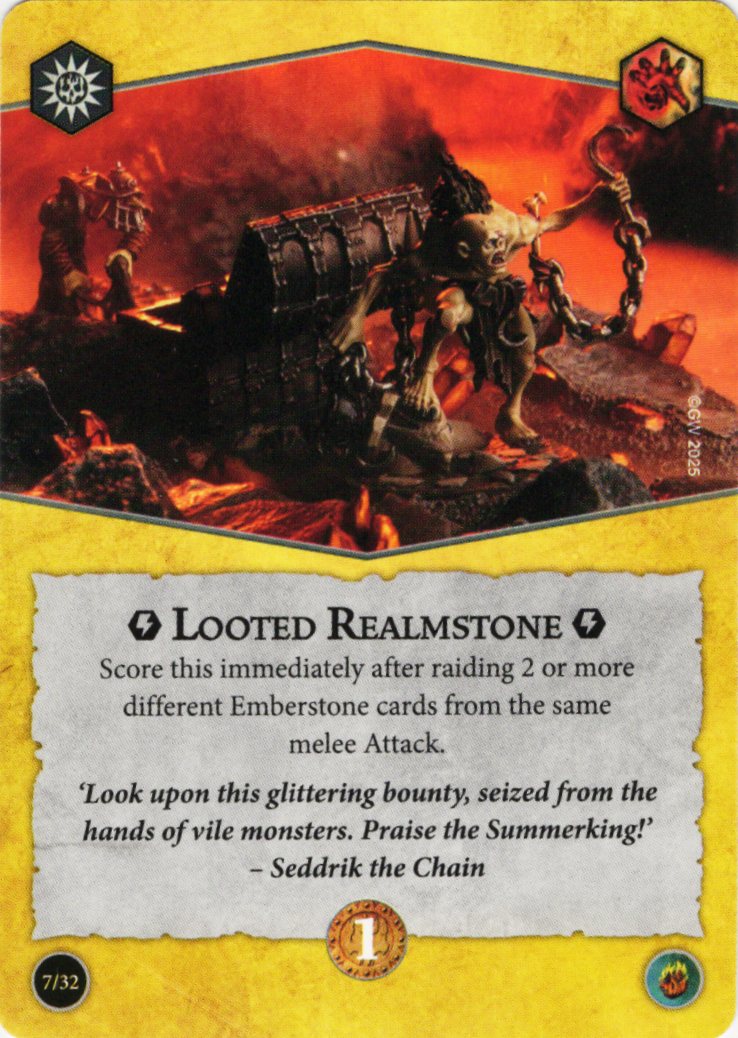
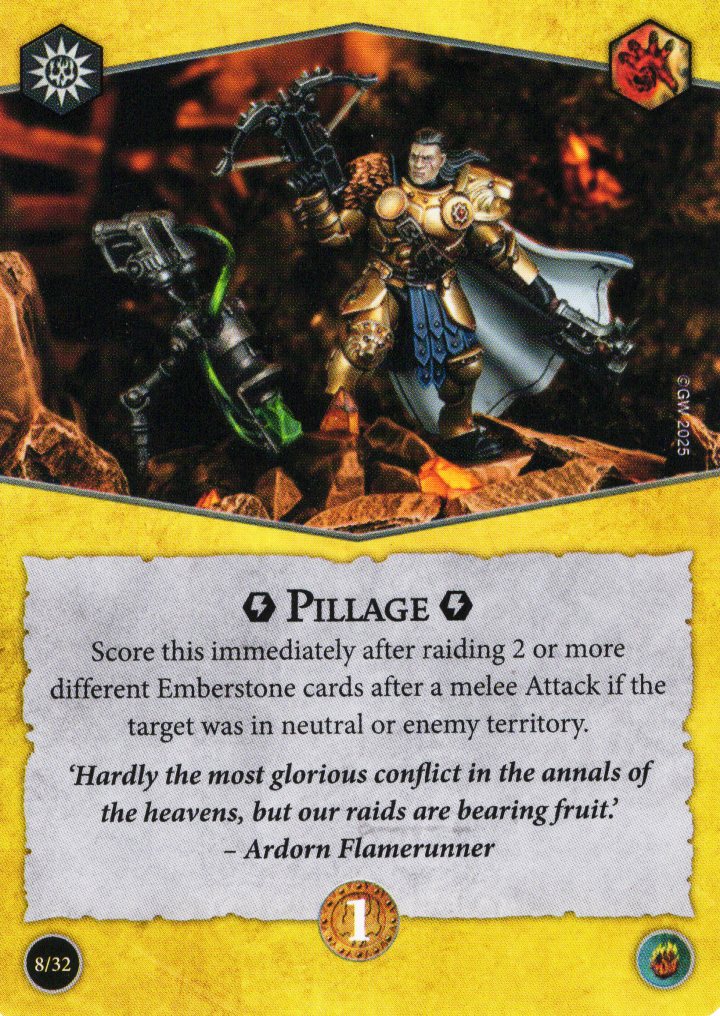
Here is where the deck really starts to get my blood boiling. Looted Realmstone is a surge for raiding 2 or more different Emberstone cards from the same melee attack. There are just so many things wrong with this, but let’s start with the obvious: good luck scoring this against horde warbands. Cheating ahead again, there are not nearly enough ways to increase your raid capability on attacks to support this card (and, in the absence of an FAQ, you could argue that the main power card which could help might not technically be considered “raiding,” but we’ll get there later). Even excusing that, you might know that your top card is Emberstone from having raided it earlier and leaving it there, but, unless you are fortunate enough to have a second one right behind it, now you are talking about raiding 3 or more cards just to have a chance at finding a second Emberstone card in the raid. Maybe if the entire power deck were Emberstone cards I could start to get behind this (still with some significant reservations due to the matchup dependence), but, as constructed, this is not even good in Rivals, much less in Nemesis.
Power Ceiling: 1, Consistency: 1, Universality: 1
Well, if you didn’t like that last one, boy do I have some bad news for you. Pillage is just the same thing but with the restriction that the target has to be in neutral or enemy territory. Because this one doesn’t say “the same” you could maybe argue that it works more like Hostile Takeover, but I think that is a pretty specious argument since it does still say “a melee attack,” not “melee attacks” or “second or subsequent” or anything like that. I actually seriously considered whether seeing a second, worse version of our previous entry on literally the next card merited updating my scoring scales to include 0. This just broke me. Printing one bad card, it happens. Copy/pasting that and making it worse is just unconscionable.
Power Ceiling: 1, Consistency: 1, Universality: 1
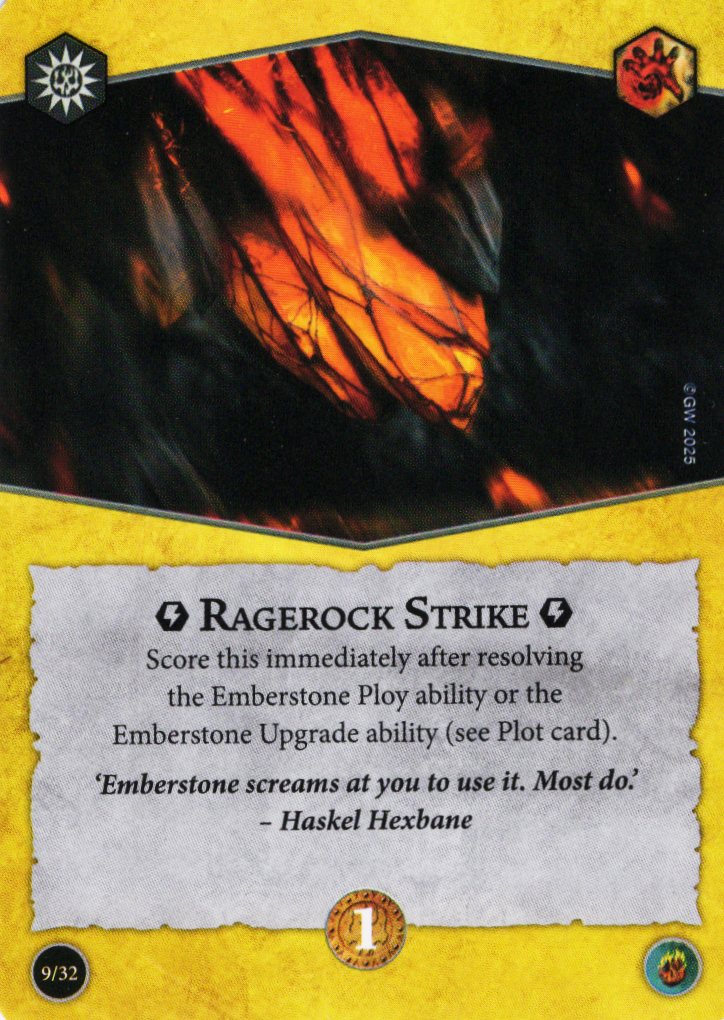
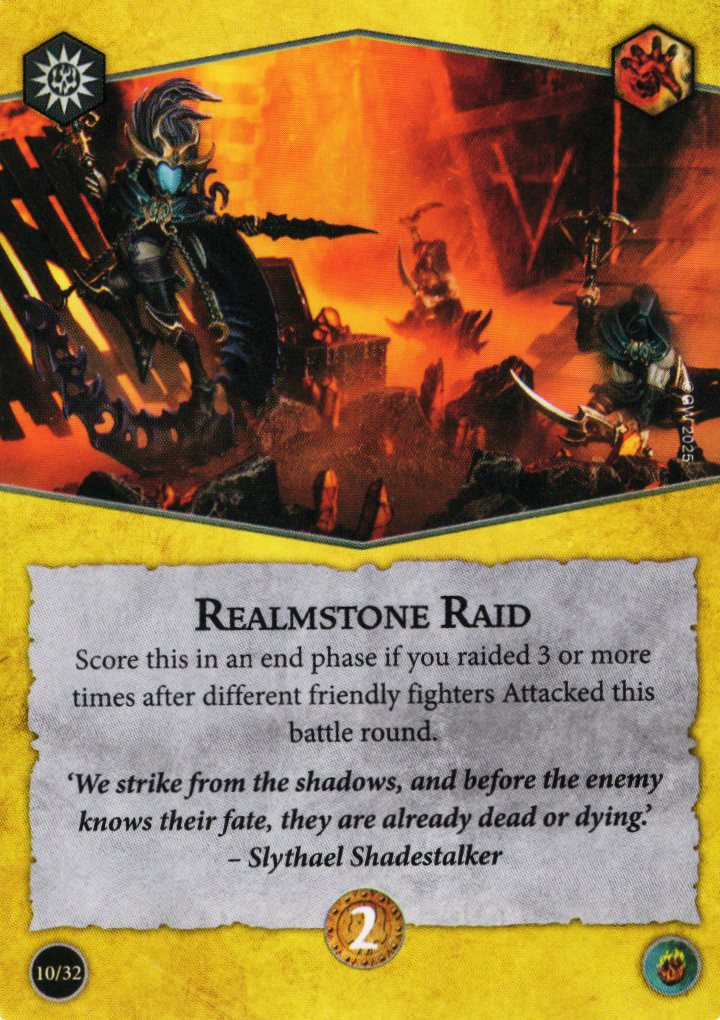
On a happier note, Ragerock Strike was able to dissipate my own rage a little bit, scoring immediately after resolving the Emberstone ploy/upgrade surge ability to use/equip it upon raiding. Finally, a raid surge that doesn’t really make you jump through extra hoops! Sure, you have to immediately use the Emberstone card in this case instead of putting it to the top or bottom of your deck, but doing so is essentially what is appealing about the deck in the first place. You’d generally rather be using Emberstone cards as you raid them to augment the rate at which you use up your power deck and scoring for doing that is just gravy. Yes, you can’t necessarily guarantee that the card you raid will be Emberstone, but when it happens, this will essentially score as just “make a successful melee attack,” which is a surge you would take in pretty much any deck.
Power Ceiling: 3, Consistency: 2, Universality: 3
Next up is Realmstone Raid, a card that makes me want a lot of FAQs. This one grants you 2 glory if you “raided 3 or more times after different friendly fighters attacked this round.” Starting with RaW, my understanding is again, per the plot card, that the number of “times” you raided refers to how many times you revealed a card per the raid rules, not the “instances” of you raiding one or more cards. That said, if I read this as literally as possible, if one of my fighters attacks and raids 3 times off that one attack, as long as I made an attack with any of my other fighters this round, I feel like I should score this, regardless of whether the second fighter raided or not. However, the way this card is phrased makes it seem like it is checking instances, not “times” the way that the plot card defines it. If that’s the case, am I still considered to have raided in cases where I hit a 0 Bounty fighter? This is honestly the hardest time I have had interpreting how a card is meant to work since I’ve started playing Underworlds. If I give it my first and loosest interpretation, I think it’s actually pretty good, but there are a lot of ways this can go, so I am going to reserve my scoring until we get some official guidance on how this actually works.
Power Ceiling: ?, Consistency: ?, Universality: ?
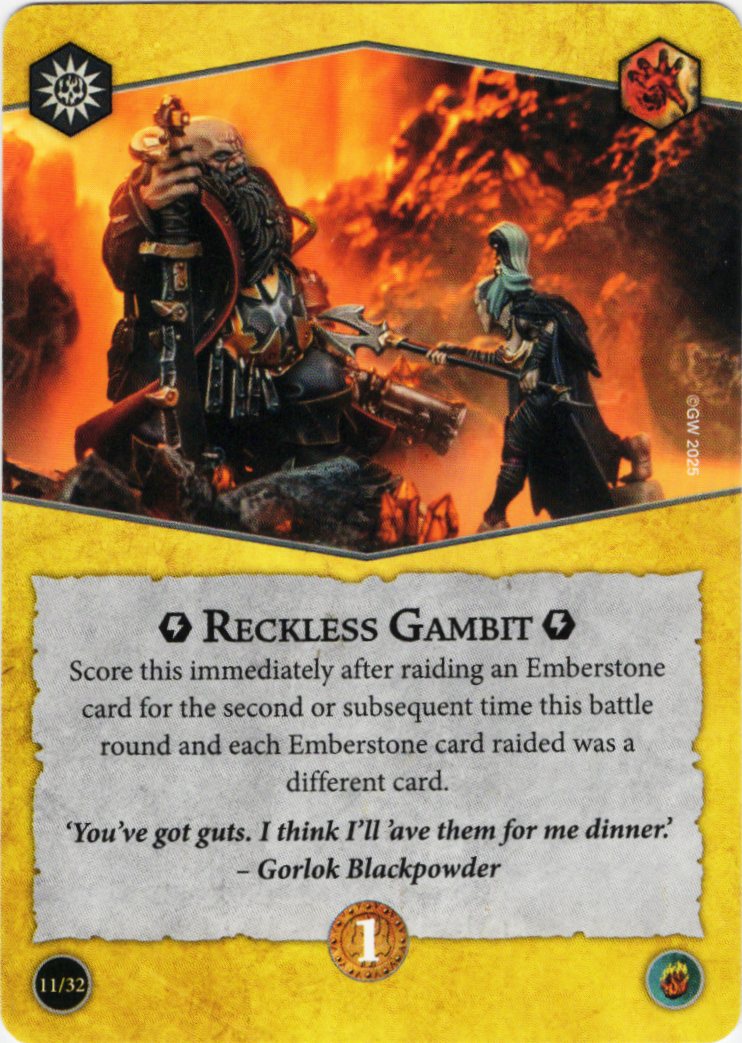
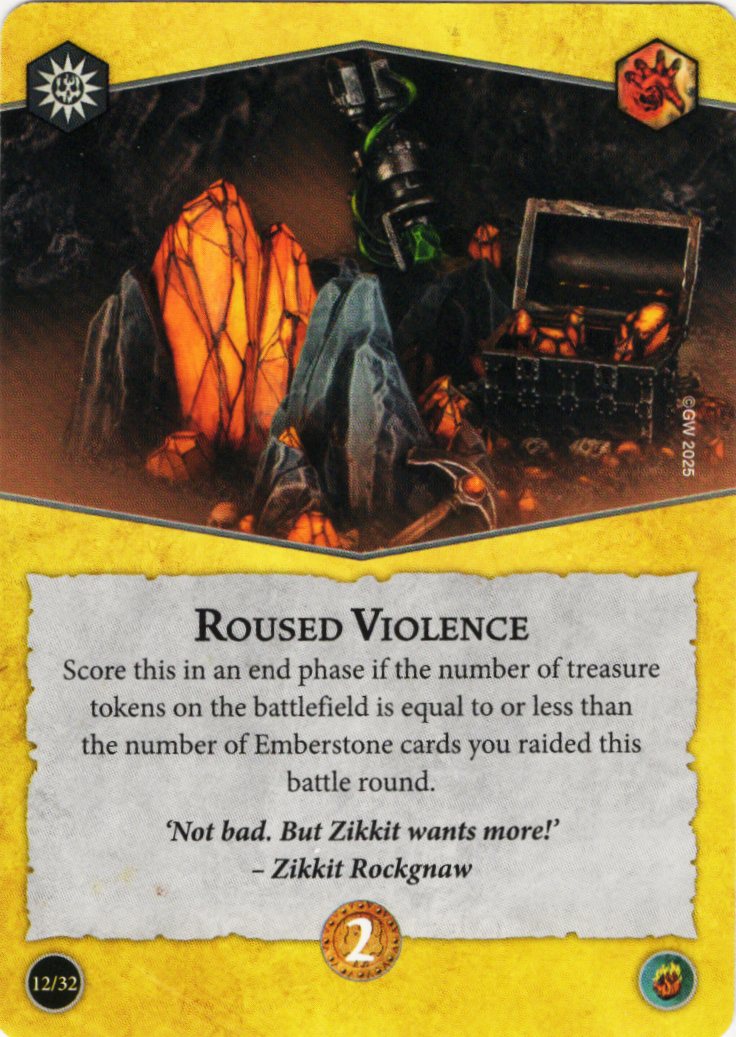
Reckless Gambit is our final surge, scoring immediately after raiding an Emberstone card for a second or subsequent time in the round and each was a different card. The dreaded “and each” strikes again. Yes, this works just fine if you plan to play all of your Emberstone cards as soon as you raid them, but the second you put one of them back on top of your deck from a raid, you are bypassing scoring this for the round, as the next time you raid will break the “and each” condition. So close to being a good card, but that small little hiccup probably takes it from “usually include” to “almost never include.”
Power Ceiling: 2, Consistency: 1, Universality: 2
Our final objective is Roused Violence, another 2-glory end phase scored if the number of treasure tokens on the battlefield is equal to or less than the number of Emberstone cards you raided in the round. While this will again require you to put some investment into your power deck in terms of packing enough Emberstone cards, this has some great direct synergy with PnP scoring. Run around hitting people and delving tokens to cover and you get to score your surges en route to an end phase that might include this, Torn Landscape, and Broken Prospects. Notably, this can also play nicely against PnP decks since they will likely be doing some of your work for you. On top of that, if you happen to raid as many as 5 Emberstone cards, your opponent actually cannot stop you from scoring this. Pretty solid card to finish off the objectives.
Power Ceiling: 2, Consistency: 2, Universality: 3
Ploys
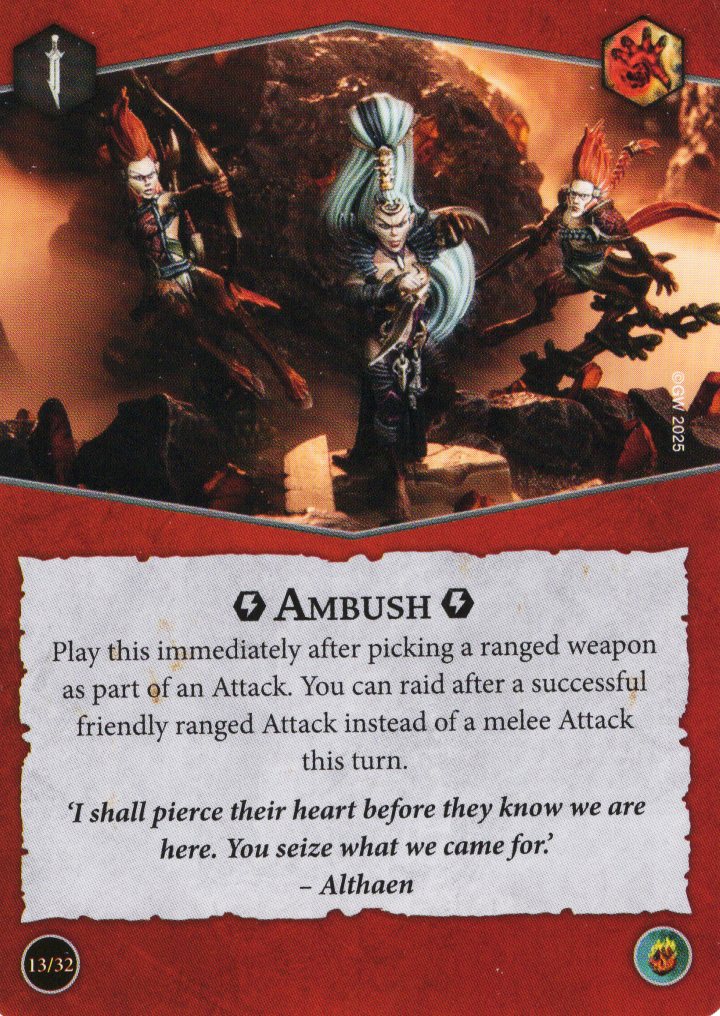
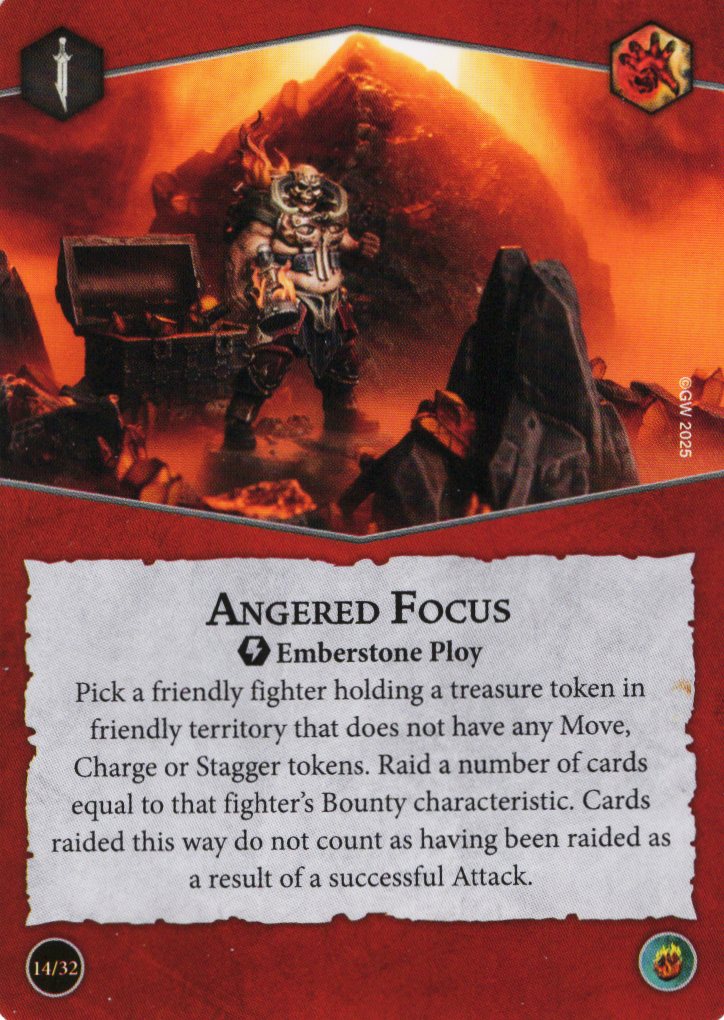
Our first ploy is Ambush, which is a surge ploy after you choose to make a ranged attack that lets you raid from ranged attacks instead of melee. This one is just a yikes to me. If you’re playing this deck, just make sure to use a warband that makes a lot of melee attacks in the first place and ta-da, you’ve saved yourself a ploy slot. The worst part is that you could play this and still miss your attack and it does nothing. As we talked about on the podcast, this would have been better as a domain that lasted all round if you wanted to open up some lines to play the deck with ranged warbands.
Power Ceiling: 1, Consistency: 2, Universality: 1
Next up is Angered Focus, our first Emberstone ploy. Raiding in the power step is an attractive prospect both to support your raid-related objectives and to keep the deck cycling rolling. Value here is particularly linked to if your warband has access to push tech to land on tokens without needing to move or charge, as it gives you better odds of playing this even in the first round. Raiding equal to the Bounty characteristic of the fighter makes this most attractive for 2+ Bounty fighters, but drawing this in anything but the first round when you’re playing a treasure token-centric build could mean you’re just set up to take advantage in later rounds.
Power Ceiling: 2, Consistency: 2, Universality: 2


The next Emberstone ploy is A Step Ahead, which lets you push a friendly fighter in neutral or enemy territory 1 hex closer to an enemy fighter. While the directional restriction is pretty negligible, needing to be in neutral or enemy territory is a bit unfortunate unless you are playing a more aggressive build. I don’t think it needed that since the directionality of the push already satisfied a design goal of “worse Sidestep.” Still, pushes are pushes and while this one is more limited than most, packing it in as some redundancy will make it valuable anyway.
Power Ceiling: 2, Consistency: 2, Universality: 3
Fortune Faded brings some echoes of Fault Lines, but requires you to be adjacent to the fighter you are trying to ping with the friendly fighter you don’t mind eating a ping. Bit too situational for me unless you are using like Gorechosen and just looking for 2 free blood tithe. If you have ping finishers available on your warscroll, maybe this becomes a bit more attractive, but I’ll take CtC if I am looking for ping cards, this just doesn’t really feel like it supports much that the deck is trying to do. If this were at least an Emberstone ploy maybe I’d consider it a little more strongly.
Power Ceiling: 2, Consistency: 2, Universality: 1
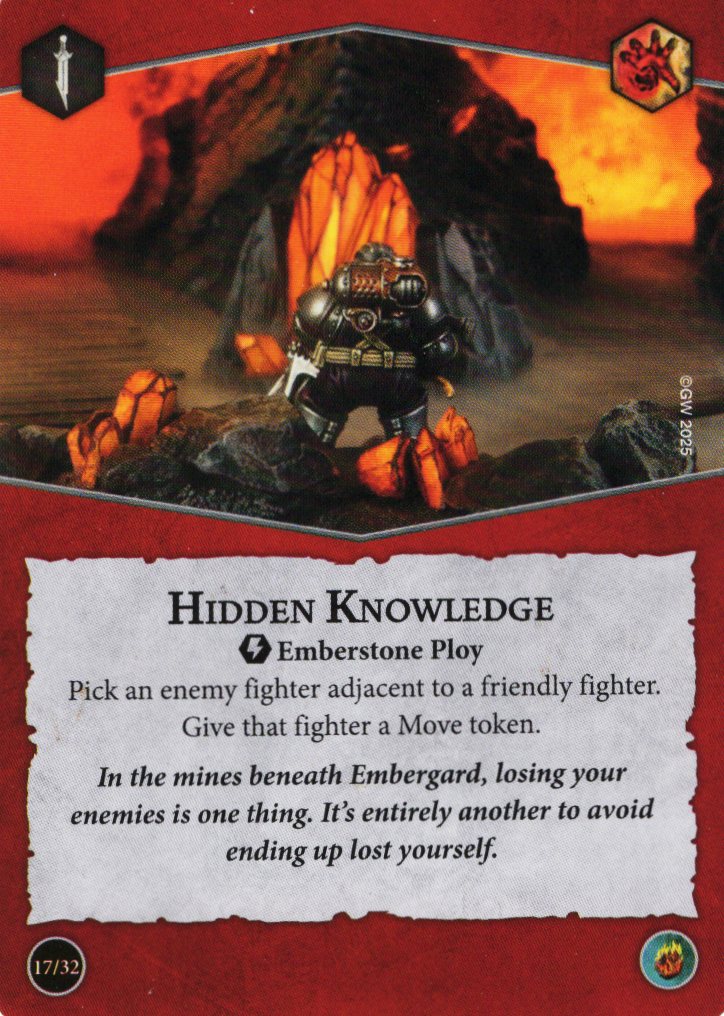
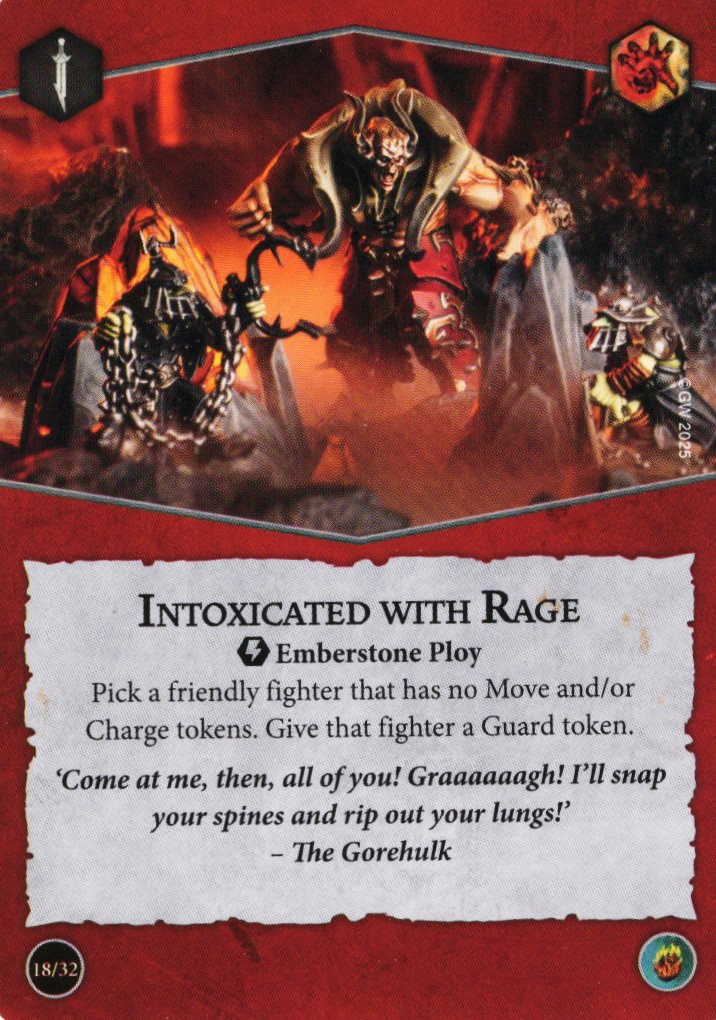
Speaking of Emberstone ploys, our next one is Hidden Knowledge, which slaps a Move token on an enemy fighter adjacent to a friendly fighter. As was the case with Spiteful Traps, gatekeeping people from reaching a charged out state or just stopping a particular threat from charging one of your important fighters is generally pretty handy. My concern here is the adjacency because, failing a backup plan to push or teleport away, they can certainly still hit the fighter that dropped this on them. The best case I can think for using this is with a fighter who yields 0 Bounty if they put themselves at risk to protect your lynchpin fighter like Crackmarrow or Sepulchral Warden, which is admittedly a pretty strong application for the card. I think this ends up as an 11th or 12th ploy in a lot of instances, but certainly has decent enough utility that you’d put it in a more raid-centric build.
Power Ceiling: 2, Consistency: 2, Universality: 2
Next up is Intoxicated with Rage, which simply slaps a guard token on a friendly fighter that has no Move or Charge tokens. One of the more restrictive guard ploys we’ve seen in this edition, I’d generally rather have my guard token after I have moved or charged (usually onto a feature token) rather than before. Still, guard is good enough in this edition that pretty much any warband with access to multiple defense dice ought to consider it. As far as Emberstone ploys go, it’s also one you would almost never mind raiding and just getting the effect out immediately, whereas other such ploys might like some setup or to be saved for use at a more opportune point in the game. A couple warbands that come to mind here are Thorns and Beastgrabbaz, as they each have a bunch of 2-Dodge fighters that appreciate the guard tokens and have access to significant warscroll push tech that can get them onto tokens. Side note: Gorehulk canonically has no chill.
Power Ceiling: 2, Consistency: 2, Universality: 2
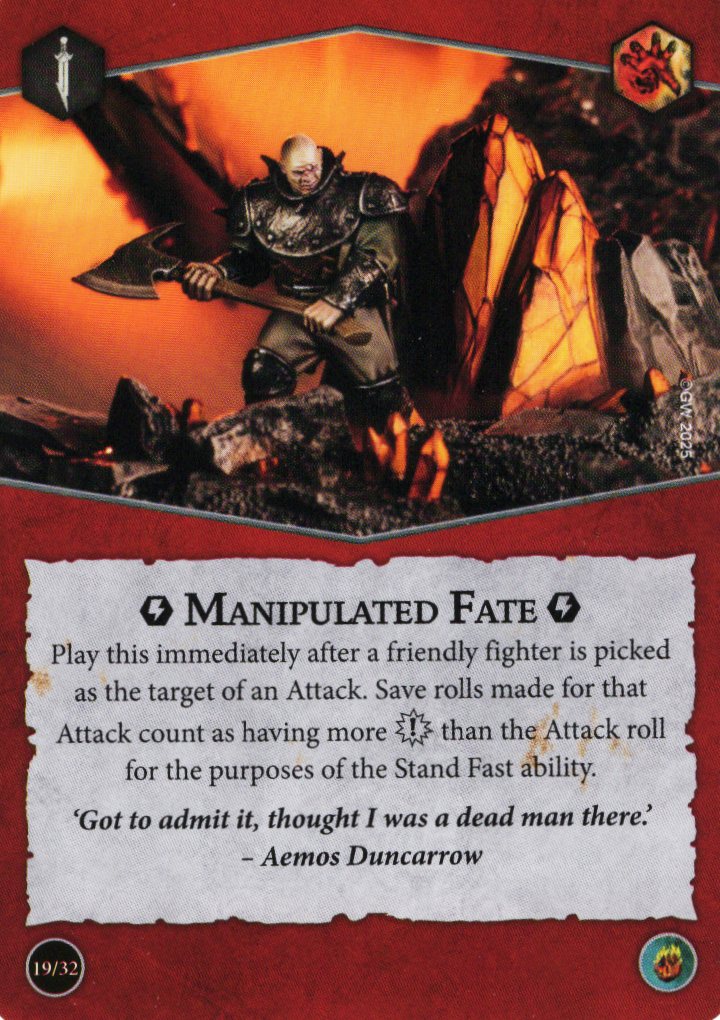
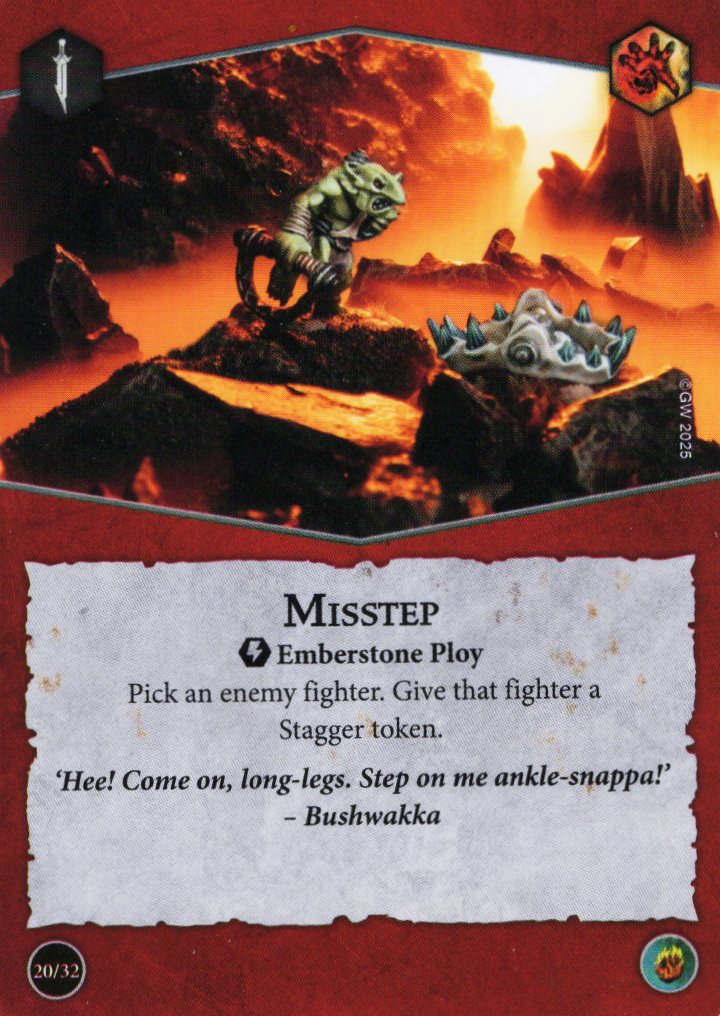
Manipulated Fate is one of the best ploys we’ve seen in this edition, without question. For those who remember back to the first edition days playing against Rippa’s Snarlfangs, Hexbane’s Hunters, or any other warband that had access to an effect like this, you know how impactful this can be. The surprise value of “actually, you do one less damage than you think and now you don’t kill me” was already phenomenal, but also not getting driven back is just the cherry on top, allowing you to secure positional scoring or just plain set up for an easier time swinging back at the attacker. Notably, the window for this is actually after cards like Twist the Knife or Determined Effort, so, while you want to make sure you give your opponent plenty of time to play their surges first, they can’t reactively play those cards once Manipulated Fate has been played.
Power Ceiling: 3, Consistency: 3, Universality: 3
Tough act to follow, but Misstep, our next Emberstone ploy, is perfectly serviceable. Staggering an enemy fighter of your choice might mean you get that re-roll on multiple attacks in the round, which is a nice accuracy boost if you are looking to do some raiding, particularly if the chosen fighter has a high Bounty characteristic and might offer you several instances of high-value raids that round. Like Intoxicated with Rage, it’s also a relatively timing-independent effect, so you will not mind at all if you just raid it and play it immediately.
Power Ceiling: 2, Consistency: 2, Universality: 3
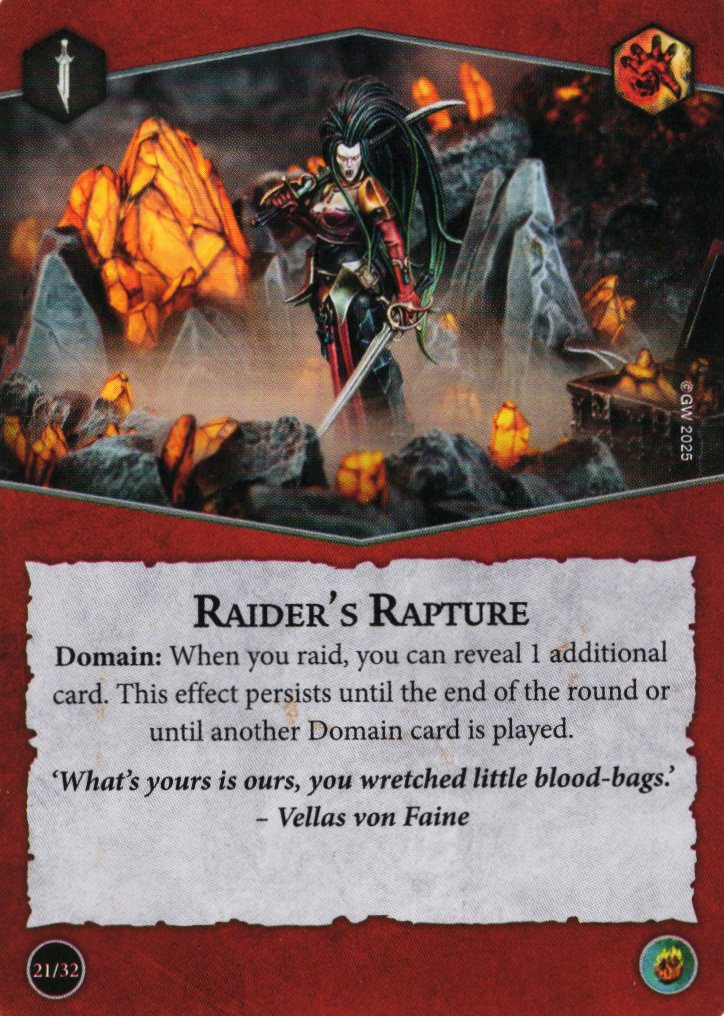
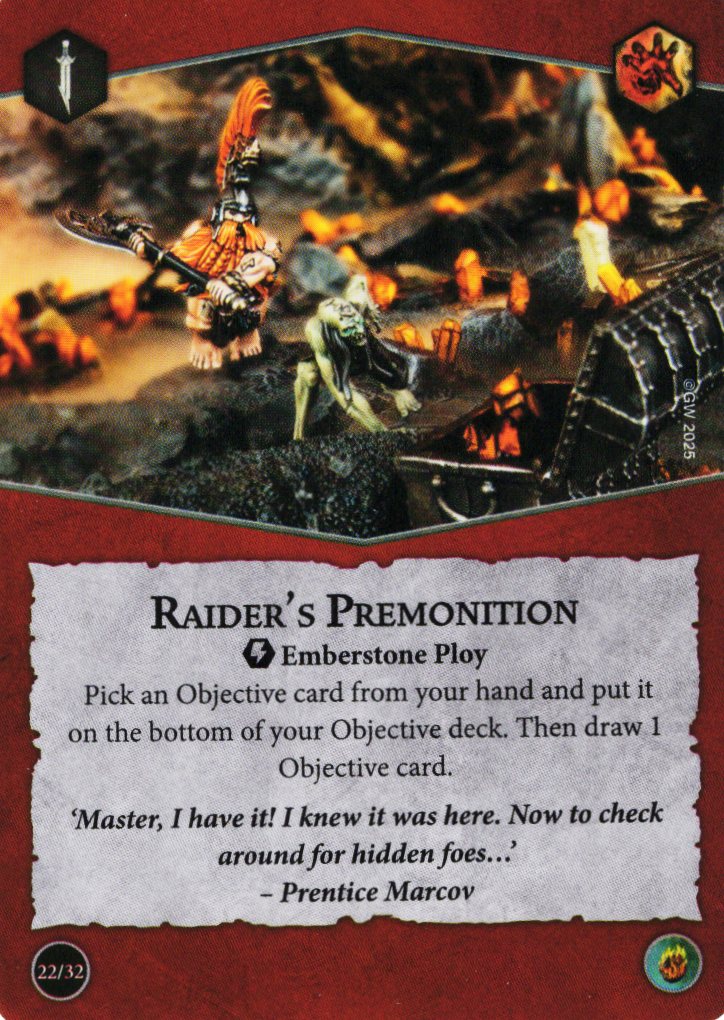
I hinted at it earlier, but Raider’s Rapture is a domain that lets you reveal 1 additional card when you raid. While I think the intent is that the extra card is considered to be raided for the purposes of objective scoring and/or using the surge ability for an Emberstone card, it is unclear to me whether this counts as raiding an additional “time” or if you are still only raiding once but revealing two cards. It’s not that I dislike the raid concept as a whole, I think it is actually a cool bit of design, I just wish a bit more care was taken with the rules language on some of the cards and this is one of them. If this is considered an additional “time” of raiding, I think this is actually pretty important support for some of the objectives in the deck, as well as critical for churning back through your deck if you happened to send something important to the bottom. Conversely, it could also mean that you send multiple critical cards to the bottom by accident instead of just one, but that’s the risk inherent with the deck anyway.
Power Ceiling: 2, Consistency: 1, Universality: 3
Our last ploy (Emberstone or otherwise) is Raider’s Premonition, which gives you some objective deck manipulation. As we discussed when reviewing Foretold Wisdom for Knives of the Crone, I think this effect is generally pretty underrated. While you can’t combine this with CtC objectives due to the plot card restriction, my other points about objectives you want later or when you have particular power card support in hand still apply, perhaps even more so considering this deck also gives you the ability to send power cards to the bottom of your deck. My only complaint is that you have to take a card out of your hand before you see what objective you draw, it would’ve been just that little bit more consistent if the order of operations were reversed there.
Power Ceiling: 2, Consistency: 2, Universality: 3
Upgrades
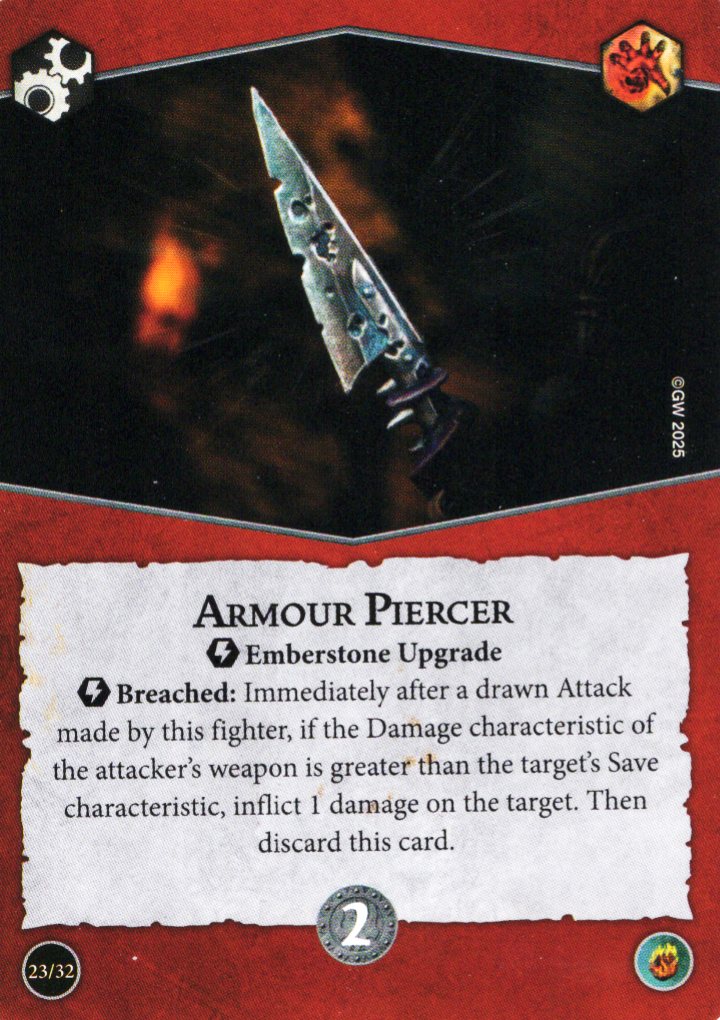
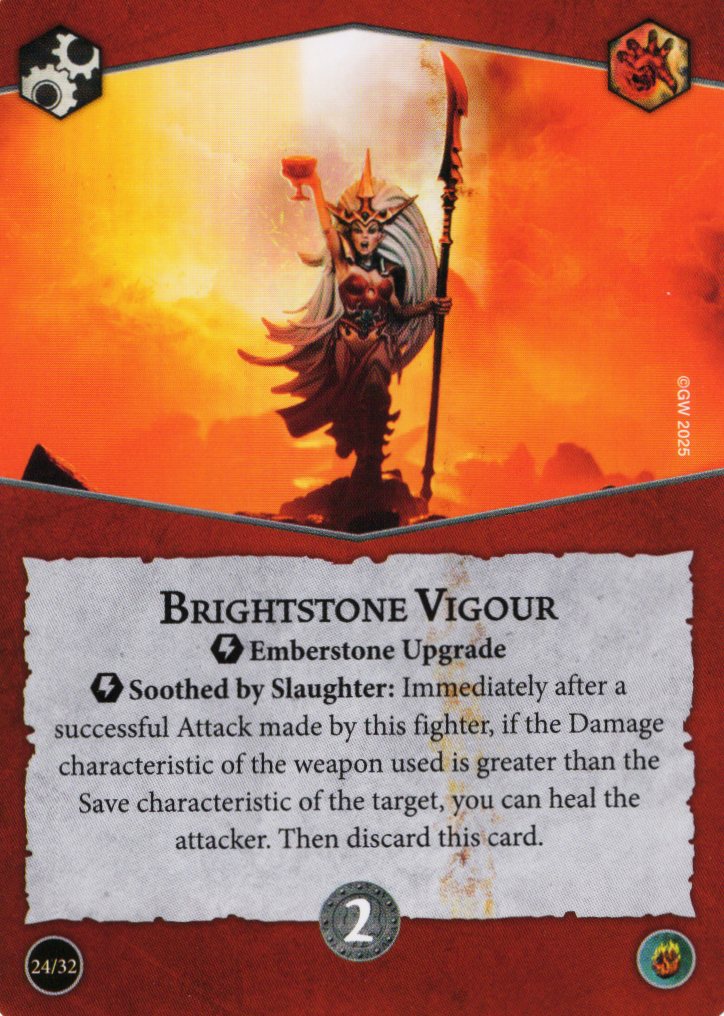
Our first Emberstone upgrade is Armour Piercer and it is honestly hardly worth discussing. 2 glory for an upgrade that only pings on draws and only if those draws were made using a high enough damage attack to exceed the target’s Save characteristic and it breaks after one use? Absolutely not, I would rather just spend my 2 glory on something like Keen Eye (spoilers) and actually hit my attack instead. This would be a lot more compelling if it also worked on successful attacks for a one-time +Damage on top of grievous, but, as written, it is just not worth playing, even despite the Emberstone tag.
Power Ceiling: 1, Consistency: 1, Universality: 1
While I think it is still a bit pricy at 2 glory, Brightstone Vigour is more in line with the power level I’d like to see from my Emberstone upgrades. Having the same Damage > Save requirement as our previous entry does hurt this one a little bit, but big boys with big bonks like Mollog, Kainan, or Wielder are the ones most benefitting from heals in the first place, so this one seems a pretty decent inclusion, as for them it will essentially be an extra copy of Great Fortitude (if they are already damaged and can proc the heal).
Power Ceiling: 3, Consistency: 2, Universality: 2
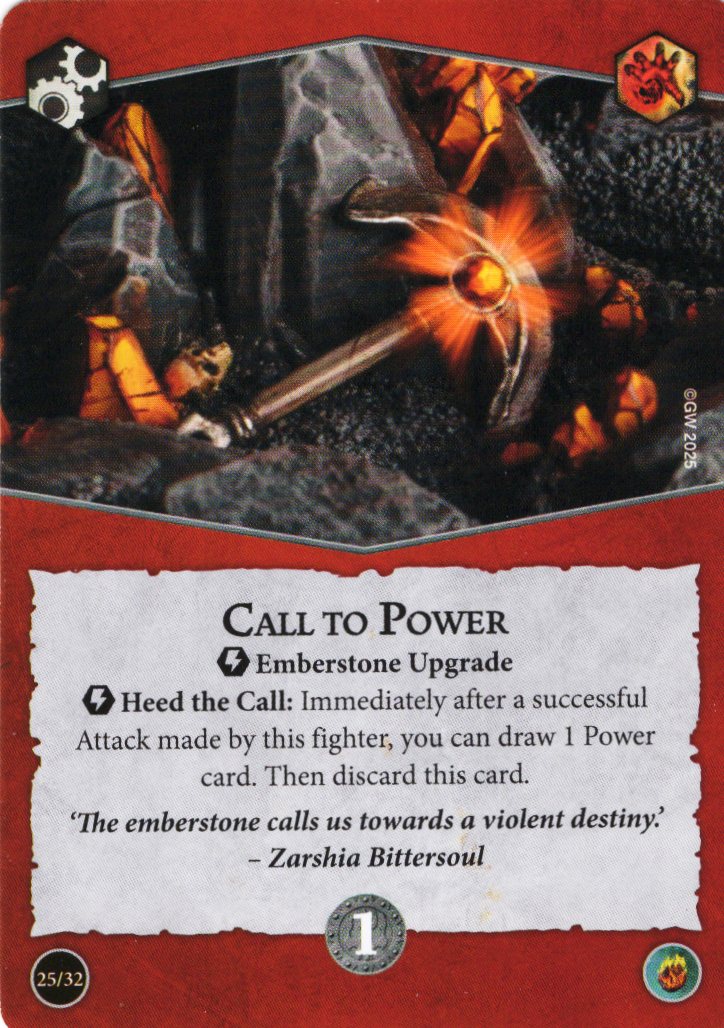

One power card for one power card is ok deck thinning and that is what Call to Power offers you. If you have some really strong power cards in your deck and want to make sure you see all of them as frequently as possible, this is capable of helping you in that effort. If you account for the case where this card gets raided and equipped, it can sort of be a “draw 2, discard 1” effect. Doesn’t exactly blow me away, but I could see it slotting in to pairings where there’s not an obvious 10th choice for your upgrades.
Power Ceiling: 2, Consistency: 2, Universality: 2
I don’t even know where to begin with Emberstone Edge. 2 glory for a 1R/2H/1D weapon that could potentially get an extra die if you’ve already raided this phase is just not fair value when I can just pay 1 glory for a card like Desperate Rage or Burrowing Strike. I just don’t understand what warband is extracting significant benefit from this profile. If the dice stacked based on how many times you’d raided or you could potentially add a die and a damage, I could understand the cost, but this upgrade should just be free as far as I am concerned (and still probably wouldn’t see play), 2 glory is outrageous.
Power Ceiling: 1, Consistency: 1, Universality: 1
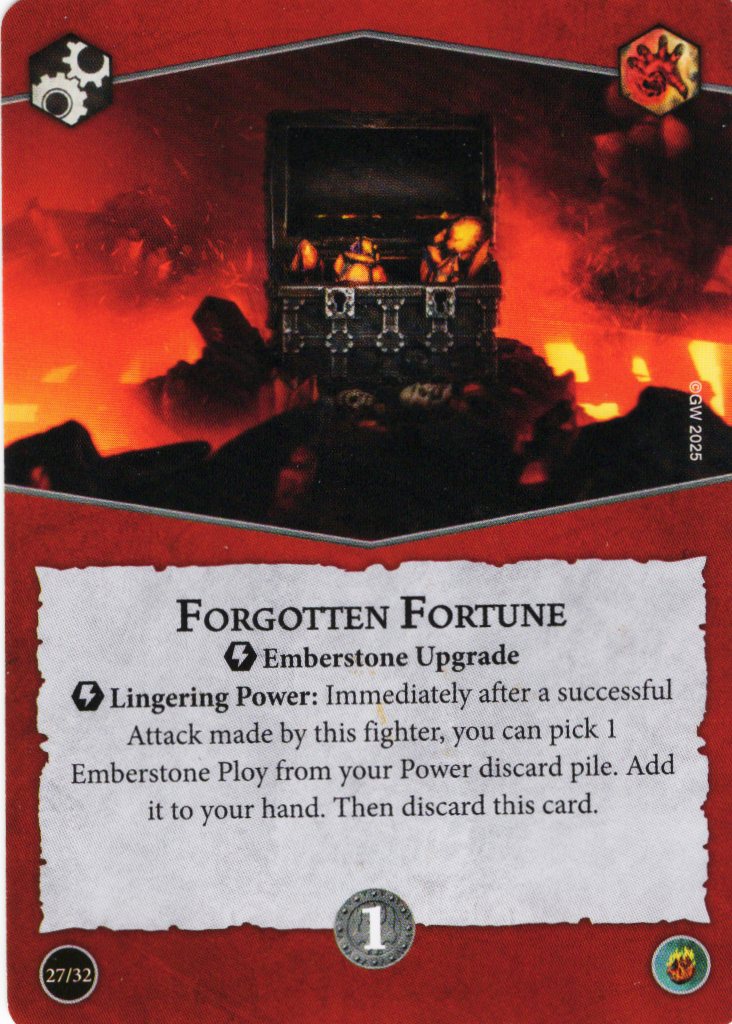
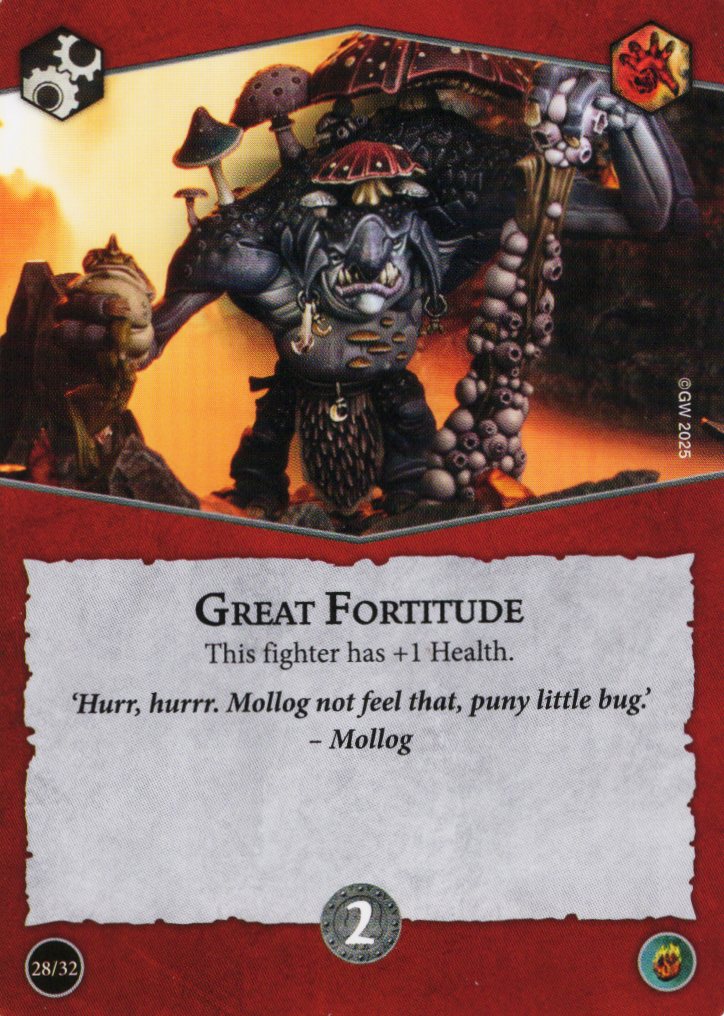
Y’all know I enjoyed some Plunder the Graves back in first edition, so Forgotten Fortune grabbing an Emberstone ploy out of your discard is mildly intriguing, as they are generally good enough that I could see playing them twice as being worth an upgrade slot. That said, I would also happily have paid 2 glory for this if it let me pick any ploy out of my discard. Given that we’ve already seen two 2-glory upgrades that are absolutely not worth that price tag, I’d be thrilled to just swap its cost with one of those for that boost in effectiveness. As is, still plenty useful, just a missed opportunity to expand into synergy with a wider range of cards.
Power Ceiling: 2, Consistency: 2, Universality: 3
Having Great Fortitude in the deck together with a heal and auto-Stand Fast card definitely starts to ring some bells about pairing this with deck big boys, particularly if you happened to be playing with a pairing that slots in Healing Potion as well. On top of that, not much to say, great is right in the name!
Power Ceiling: 3, Consistency: 3, Universality: 3
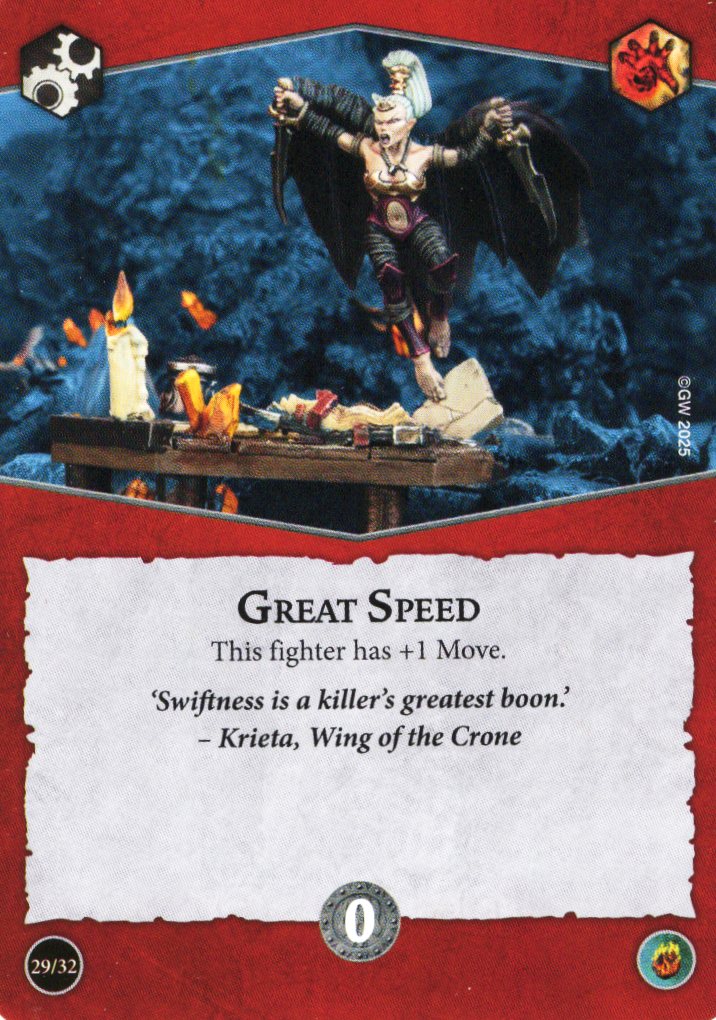
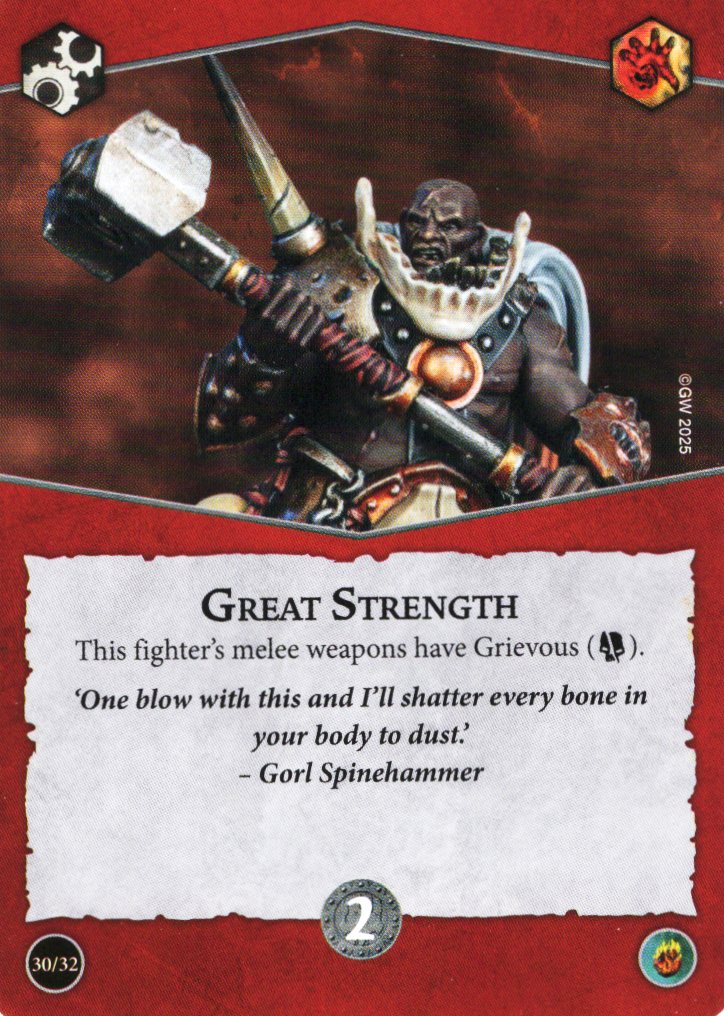
Another familiar face here with Great Speed, which is a card I’ve really come to appreciate in the new edition. Being free to equip was a fantastic change to this card, as it made it generally more valuable to me than the one-time +2 Move ploys you would see with something like Wings of War, particularly for warbands with base Move characteristics of only 2 or 3. Sure, not every warband will need the extra movement, but it’s become a staple for me on those that do.
Power Ceiling: 2, Consistency: 3, Universality: 2
Completing the “great” trifecta, we have just our third instance of Great Strength, the classic “always taken, but never busted” card of Warhammer Underworlds. Basically essential fare in any deck where it’s offered, it’s nice to have the option to take it without needing to run Blazing Assault or Emberstone Sentinels.
Power Ceiling: 3, Consistency: 3, Universality: 3
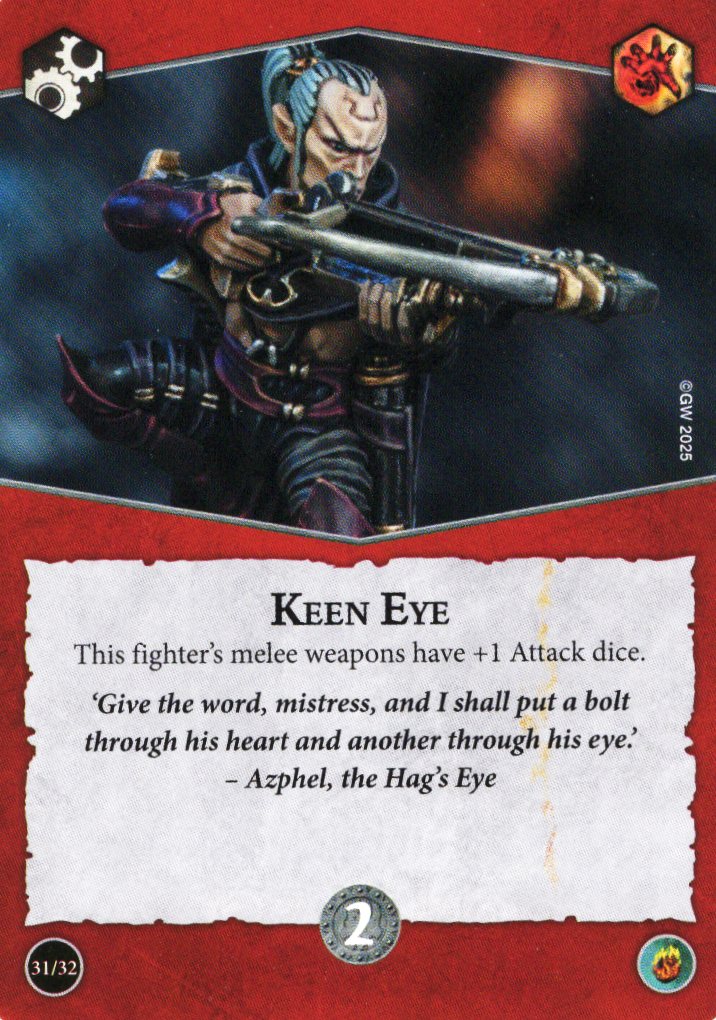
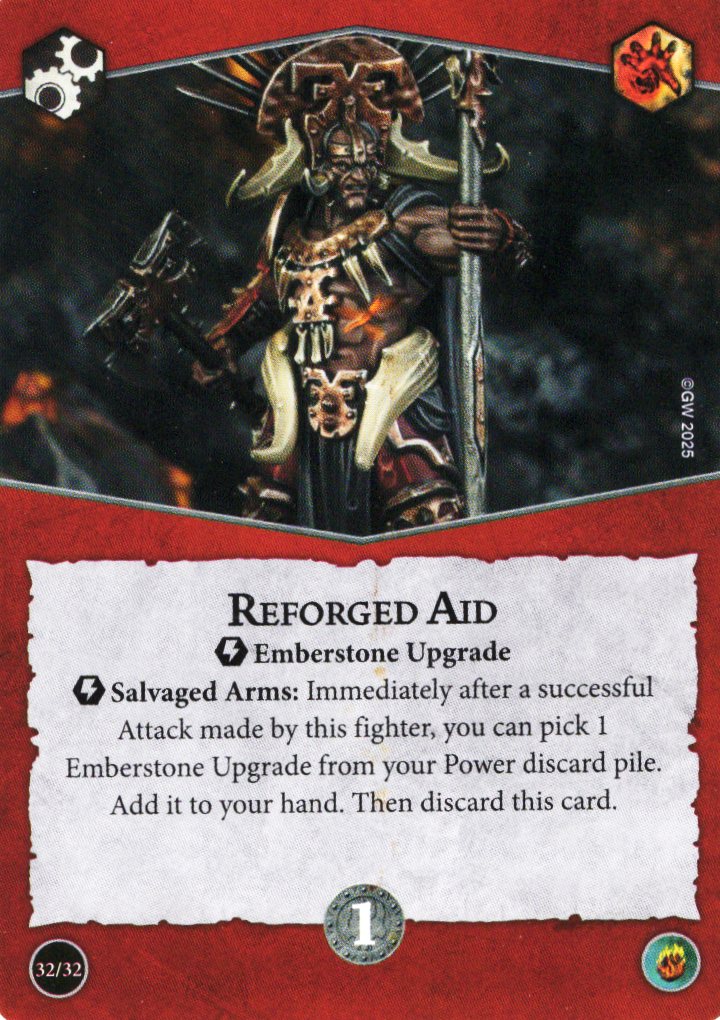
Continuing the trend of must-takes, Keen Eye provides the deck with some much-needed accuracy to keep those raids coming. I’d actually like to have seen a tad bit more accuracy somewhere in this deck (perhaps a +Dice Emberstone ploy of some kind?). More generally for the 4 cards we’ve just covered, while I can’t complain too much because they are all very good, I can’t help but feel like it might have been more interesting to rename them and make them Emberstone cards while slightly reducing their effectiveness. For example, you could add the clause “if you raided an Emberstone card this round” or something at the end of all of their rules text to temper the effects but give them more innate synergy with the deck.
Power Ceiling: 3, Consistency: 3, Universality: 3
Our last card in the deck is Reforged Aid, the counterpart to Forgotten Fortune in that it grabs an Emberstone upgrade out of the deck instead of a ploy. Ironically enough, Forgotten Fortune probably is the one I’d most want to dig out of the pile, although Brightstone Vigour would be another compelling choice. Given that I think the Emberstone ploys are generally a bit more powerful than the upgrades, this one gets takes a little bit of a hit in value when compared to its partner.
Power Ceiling: 2, Consistency: 2, Universality: 2
Conclusions
Overall, this deck is a mixed bag for me. On one hand, there are some very unique options presented both in the card effects themselves but also via the effective card draw you get out of resolving Emberstone card raids. That said, I think the surge objectives are mostly dreadful and the Emberstone upgrades largely disappoint. Thankfully, you’ve got several great staple upgrades to make up for that a little bit, but I just feel that the Emberstone ploys did a much better job of toeing the line between power level and accessibility than the upgrades did, especially considering there are a couple of major headscratchers in there. While I don’t want to harp on it too much, I also feel like there was a bit of a decline in clarity with a lot of the rules language here when compared to earlier decks in this edition, some of which we can’t do much with other than to come to community consensus while we wait for an official FAQ.
Regarding the competitive viability of the deck as a whole, I think, barring some significant nerfs, this has definitely not knocked CtC off its podium as the premier plot deck in the Nemesis format. That said, it does do something unique via its plot card, which is not something that Edge of the Knife can claim, and so I think that will give it a few more viable landing spots. Having access to power deck manipulation that can double as essentially free card draw not only opens up synergy with particular cards and game states, but also oozes theoretical synergy with future card designs. While we don’t know yet where that design will go, it’s easier to imagine that deck thinning and/or manipulation would offer more potential synergy with any given power card than tempered. Looking at current releases and Nemesis building, I think it is easy to fall into a pairing with Blazing Assault since it offers you additional accuracy to more consistently raid. However, I feel this could actually be a bit of a trap. In this pairing, I think you would be hurting one of your two decks in the place where they are strongest, which is in the ploys. Either you forego a lot of Emberstone ploys to keep the overtly stronger ploys in BA, in which case you are sacrificing a lot of raid synergy, or you keep the RR ploys to have a bit more objective deck synergy at the cost of the average power level of your cards. I think the pairing I lean towards instead is PnP, as you can very feasibly just dip your toes into the good stuff of this deck without having to include much scoring related to raiding Emberstone cards since PnP has such a good objective deck. You can take the coveted Gloryseeker/Great Strength combo and scoop other strong cards like Keen Eye, Great Fortitude, and Manipulated Fate to fill a few holes in what is already one of the best decks in the game. For some more fringe pairings, Reckless Fury has some attractive lines as a pseudo-“invading aggro” build and can actually fill in some holes in the relatively poor objective package offered by RR if your warband lends itself to that playstyle. While these pairings might have more glaring issues in matching up the objective card deficiencies in RR, even Emberstone Sentinels and Wrack and Ruin both offer some nice synergies in more specific instances than our earlier mentions and can still hit some relative highs with the right warband, although I think these builds will likely have less general appeal when compared to aforementioned deck pairings.
Well, that’s it for now. Please let us know what you think of the new deck and what warbands/Nemesis pairings you are looking forward to trying out. As always, we wish you the best of luck on YOUR Path to (raided) Glory!


